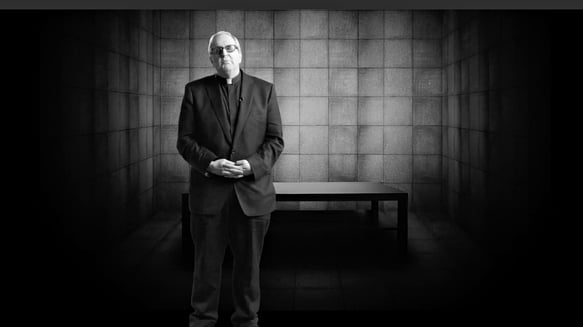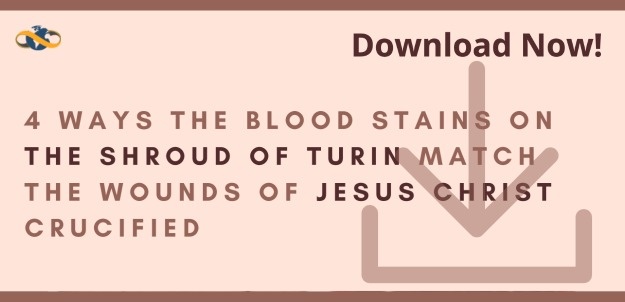The Shroud of Turin is a burial shroud of linen cloth woven in a 3:1 herringbone pattern. Measuring 14 feet 3 inches in length and 3 feet 7 inches in width, it is a single piece of cloth bearing a front and back image of a crucified man. While The Church does not recognize nor deny the origins of the Shroud, it remains an important artifact within the Catholic faith and is one of the most studied artifacts in the world.
Discovered in the 1350s in medieval France, the Shroud caused the ex-communication of Margaret de Charny, survived a fire in Sainte-Chapelle in Chambéry, and was hidden from the Nazis during World War II.
In 1988, a carbon 14 test was performed on the Shroud. The results concluded that the cloth was from the mid-thirteenth century. However, the samples were only taken from a small area of the cloth—the section was later repaired after the fire in Sainte-Chapelle.
Later tests have placed the origins of the shroud to A.D. 50 (give or take 200 years) with a 96% certainty. Furthermore, the pollen on the cloth is unique to Judea, the woven pattern is the product of first-century techniques, and the AB blood stains predate the image on the cloth.
To this day, The Shroud of Turin still calls to people worldwide. From scientists to artists, from the faithful to the searching, many modern projects have been inspired by the famous artifact. The new documentary, The Shroud: Face to Face, welcomes all to hopefully find answers to the questions that have long since surrounded The Shroud of Turin.
The Shroud: Face to Face
Robert Orlando’s newest addition to his impressive oeuvre is based on his own book of the same title. This incredible film defies the contemporary documentary genre and blends history, science, and religion. Journeying beyond his own investigative and scholarly work, Orlando invites conflicting opinions to join his venture towards the cross and the tomb to “witnesses at a crime scene with unprecedented ramifications.”
“The murder of Jesus of Nazareth, a carpenter from a small town outside Jerusalem, became the most historically debated crime scene in all recorded history,” explains Orlando. “Not only do people debate the historicity of the event, but unlike most other crime scenes, there’s a religious element. The murder of this simple carpenter somehow launches the largest, most widespread religion of modern times.”
Told in a storytelling style that will appeal to fans of true crime podcasts and television shows, the investigation (and conflicting sides of the debate) seeks to reconstruct the pivotal aspects of the Crucifixion and analyze the authenticity of the Shroud.
The voices that lend themselves to the centuries-long debate include:
- Dale Allison: American historian and Princeton Theological Seminary professor
- Cheryl White: Member of the Shroud of Turin Education and Research Association
- Mark Goodacre: Television director, New Testament scholar, and professor at Duke University’s Department of Religion
- Father Andrew Dalton, LC, STD: Professor of theology at the Pontifical Athenaeum Regina Apostolorum in Rome, who wrote the foreword for Orlando’s book
- Father Robert J. Spitzer, SJ: the Jesuit scholar, author, founder of the Magis Center, and popular EWTN television host
- Plus more!
The captivating film will be released in November of 2023.
“Robert Orlando does more than analyze an ancient archaeological object shrouded in mystery. This sleuth, scholar, and storyteller almost irresistibly draws us toward a face-to-face encounter with the one who asks each of us, ‘Who do you say that I am?’ Whoever confronts this crime scene, this question, this face—believer or unbeliever—will never be the same.” —Fr. Dalton.
Fr. Robert J. Spitzer on the Shroud of Turin
“This is the way, I think, to get the message out, and in a compelling way that doesn’t force people, that allows them to make a decision for themselves,” —Fr. Robert J. Spitzer

Why would we think the body in the Shroud was that of Jesus? As explained in the article “ Science and Shroud of Turin,” it is exceedingly improbable that the Shroud is a medieval forgery.
Firstly, there are no paints, dyes, or other pigments on the Shroud (except for the tiny flecks from the sanctification of icons and paintings that touched it).
Secondly, the anatomical precision of the blood stains—real human blood that congealed on the Shroud before the formation of the image—is in precise anatomical correlation to the image itself. How could a medieval forger have accomplished this?
Thirdly, it is exceedingly difficult to explain how pollen grains indigenous to Palestine appeared in abundance on a shroud of probable Semitic origin (if it originated in medieval Europe) and how coins minted in A.D. 29 in Palestine appeared on the eyes of the man on the Shroud. How could a medieval forger have duplicated these first-century Palestinian characteristics of the Shroud?
Fourthly, the five enigmas of the image on the Shroud almost certainly preclude a forgery. Thus, believing that the Shroud is a medieval forgery is not reasonable or responsible.
Beyond this, there are three probative kinds of evidence pointing specifically to Jesus’ place and time of origin and to His unique crucifixion and resurrection:
- The material of the Shroud, the pollen grains on it, and the coins on the man’s eyes all have their origin in First Century Palestine—where Jesus was purported to have died.
- The blood stains come from a crucifixion event identical to the one described in the four Gospels—which was very unusual, if not unique, in many respects (e.g.., being crowned with thorns, flogged, and pierced with a Roman pilum).
- The five enigmas of the Shroud’s image point to a transphysically caused burst of vacuum ultraviolet radiation from a mechanically transparent body. This suggests the transformation of Jesus’ body from a physical to a spiritual-glorified one (as stated by St. Paul and the four Gospels). The spiritual-glorified transformation of Jesus’ body was unique to the Christian view of resurrection. It was not known in
Judaism (which held to a resuscitation of the flesh) or pagan cults (which held to ethereal or ghostlike views of immortality). Thus, the enigmas on the Shroud’s image point to the uniquely Christian view of resurrection implied by Jesus’ risen appearance.
The odds of this First Century Palestinian burial shroud—with the unique features of Jesus’ crucifixion and resurrection—being that of anyone else is exceedingly remote. Since the image is not a forgery, and it originated from a real person living at the time of Jesus, crucified in the unique way of Jesus, and producing a burst of intense vacuum ultraviolet radiation from His decomposing body, who else would it be? Given all this, we might reasonably infer that the Shroud is the burial cloth of Jesus which contains not only a relic of His Crucifixion but also His Resurrection in glory. If so, it shows both the truth of the most significant event in human history and the accuracy of the Gospel accounts of it.
*taken from Fr. Spitzer’s article “Science and Shroud of Turin.”


